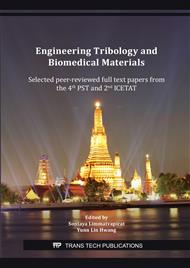[1]
S. Kittiwisut, P. Kraisit, Physicochemical characterization of propranolol-loaded chitosan nanoparticles for a buccal drug delivery, Int. J. Appl. Pharm. (2020) 243–247.
DOI: 10.22159/ijap.2020v12i4.38009
Google Scholar
[2]
P. Kraisit, S. Limmatvapirat, J. Nunthanid, P. Sriamornsak, M. Luangtana-anan, Nanoparticle formation by using shellac and chitosan for a protein delivery system., Pharm. Dev. Technol. 18 (2013) 686–693.
DOI: 10.3109/10837450.2012.685657
Google Scholar
[3]
P. Kraisit, S. Limmatvapirat, M. Luangtana-Anan, P. Sriamornsak, Buccal administration of mucoadhesive blend films saturated with propranolol loaded nanoparticles, Asian J. Pharm. Sci. 13 (2018) 34–43.
DOI: 10.1016/j.ajps.2017.07.006
Google Scholar
[4]
P. Kraisit, N. Sarisuta, Development of triamcinolone acetonide-loaded nanostructured lipid carriers (NLCs) for buccal drug delivery using the box-behnken design, Molecules. 23 (2018).
DOI: 10.3390/molecules23040982
Google Scholar
[5]
C. Tetyczka, M. Griesbacher, M. Absenger-Novak, E. Fröhlich, E. Roblegg, Development of nanostructured lipid carriers for intraoral delivery of Domperidone, Int. J. Pharm. 526 (2017) 188–198.
DOI: 10.1016/j.ijpharm.2017.04.076
Google Scholar
[6]
J. Pardeike, A. Hommoss, R.H. Müller, Lipid nanoparticles (SLN, NLC) in cosmetic and pharmaceutical dermal products, Int. J. Pharm. 366 (2009) 170–184.
DOI: 10.1016/j.ijpharm.2008.10.003
Google Scholar
[7]
V. Teeranachaideekul, P. Boonme, E.B. Souto, R.H. Müller, V.B. Junyaprasert, Influence of oil content on physicochemical properties and skin distribution of Nile red-loaded NLC, J. Control. Release. 128 (2008) 134–141.
DOI: 10.1016/j.jconrel.2008.02.011
Google Scholar
[8]
Y. Chu, D. Li, Y.-F. Luo, X.-J. He, M.-Y. Jiang, Preparation and In Vitro Evaluation of Glycyrrhetinic Acid-Modified Curcumin-Loaded Nanostructured Lipid Carriers, Mol. 19 (2014).
DOI: 10.3390/molecules19022445
Google Scholar
[9]
A. Kovacevic, S. Savic, G. Vuleta, R.H. Müller, C.M. Keck, Polyhydroxy surfactants for the formulation of lipid nanoparticles (SLN and NLC): Effects on size, physical stability and particle matrix structure, Int. J. Pharm. 406 (2011) 163–172.
DOI: 10.1016/j.ijpharm.2010.12.036
Google Scholar
[10]
D. Zakowiecki, M. Szczepanska, T. Hess, K. Cal, B. Mikolaszek, J. Paszkowska, M. Wiater, D. Hoc, G. Garbacz, Preparation of delayed-release multiparticulate formulations of diclofenac sodium and evaluation of their dissolution characteristics using biorelevant dissolution methods, J. Drug Deliv. Sci. Technol. 60 (2020) 101986.
DOI: 10.1016/j.jddst.2020.101986
Google Scholar
[11]
P. Kraisit, S. Limmatvapirat, J. Nunthanid, P. Sriamornsak, M. Luangtana-Anan, Preparation and characterization of hydroxypropyl methylcellulose/polycarbophil mucoadhesive blend films using a mixture design approach, Chem. Pharm. Bull. 65 (2017) 284–294.
DOI: 10.1248/cpb.c16-00849
Google Scholar
[12]
P. Kraisit, Impact of hydroxypropyl methylcellulose (HPMC) type and concentration on the swelling and release properties of propranolol hydrochloride matrix tablets usning a simplex centroid design, Int. J. Appl. Pharm. 11 (2019) 143–151.
DOI: 10.22159/ijap.2019v11i2.31127
Google Scholar
[13]
S. Sood, K. Jain, K. Gowthamarajan, Optimization of curcumin nanoemulsion for intranasal delivery using design of experiment and its toxicity assessment, Colloids Surfaces B Biointerfaces. 113 (2014) 330–337.
DOI: 10.1016/j.colsurfb.2013.09.030
Google Scholar
[14]
Z. Rahman, A.S. Zidan, M.A. Khan, Non-destructive methods of characterization of risperidone solid lipid nanoparticles, Eur. J. Pharm. Biopharm. 76 (2010) 127–137.
DOI: 10.1016/j.ejpb.2010.05.003
Google Scholar
[15]
H. Chaudhary, K. Kohli, S. Amin, P. Rathee, V. Kumar, Optimization and Formulation Design of Gels of Diclofenac and Curcumin for Transdermal Drug Delivery by Box-Behnken Statistical Design, J. Pharm. Sci. 100 (2011) 580–593.
DOI: 10.1002/jps.22292
Google Scholar
[16]
S. Duangjit, P. Kraisit, Optimization of orodispersible and conventional tablets using simplex lattice design: Relationship among excipients and banana extract, Carbohydr. Polym. 193 (2018).
DOI: 10.1016/j.carbpol.2018.03.087
Google Scholar
[17]
S. Duangjit, P. Kraisit, M. Luangtana-Anan, An investigation of propranolol-loaded chitosan nanoparticles for transmucosal delivery: Physical characterization, Thai J. Pharm. Sci. 40 (2016).
Google Scholar
[18]
P. Kraisit, N. Hirun, J. Mahadlek, S. Limmatvapirat, Fluconazole-loaded solid lipid nanoparticles (SLNs) as a potential carrier for buccal drug delivery of oral candidiasis treatment using the Box-Behnken design, J. Drug Deliv. Sci. Technol. 63 (2021) 102437.
DOI: 10.1016/j.jddst.2021.102437
Google Scholar
[19]
S.M.M. Moghddam, A. Ahad, M. Aqil, S.S. Imam, Y. Sultana, Optimization of nanostructured lipid carriers for topical delivery of nimesulide using Box–Behnken design approach, Artif. Cells, Nanomedicine, Biotechnol. 45 (2017) 617–624.
DOI: 10.3109/21691401.2016.1167699
Google Scholar
[20]
S. El-Housiny, M.A. Shams Eldeen, Y.A. El-Attar, H.A. Salem, D. Attia, E.R. Bendas, M.A. El-Nabarawi, Fluconazole-loaded solid lipid nanoparticles topical gel for treatment of pityriasis versicolor: formulation and clinical study, Drug Deliv. 25 (2018) 78–90.
DOI: 10.1080/10717544.2017.1413444
Google Scholar


